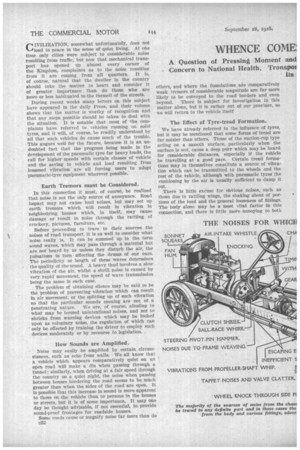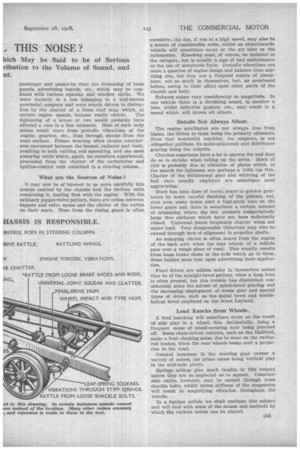WHENCE COME THIS NOISE?
Page 16

Page 17

If you've noticed an error in this article please click here to report it so we can fix it.
A Question of Pressing Moment and Concern to National Health. TranspoI hich May be Said to be of Serious ribution to the Volume of Sound, and nt.
CCIVILIZATION, somewhat unfortunately, does not lead to peace in the sense of .quiet living. At one time only cities were subject to considerable noise resulting from traffic, but now that mechanical transport has opened up almost every corner of the Kingdom, 'complaints as to the noise resulting from it are coming from all quarters. It is, of course, natural that the dweller in the country should take the matter to heart and consider it of greater importance than do those who are more or less habituated to the turmoil of the streets.
During recent weeks many letters on this subject have appeared in the daily Press, and their volume shows that the matter is worthy of recognition and that any steps possible should be taken to deal with the situation. It is notable that most of the complaints have referred to vehicles running on solid tyres, and it will, of course, be readily understood by all that such vehicles do cause much of the trouble. This augurs well for the future, because it is an undoubted fact that the progress being made in the development of the pneumatic tyre for heavy loads, the call for higher speeds with certain classes of vehicle and the saving to vehicle and load resulting from lessened vibration are all forcing users to adopt pneumatic-tyre equipment wherever possible..
Earth Tremors must be Considered.
In this connection it must, of course, be realized that noise is not the only source of annoyance. Road impact may not cause loud noises, but may set up earth tremors which will :result in vibration in neighbouring houses which, in itself, may cause damage or result in noise through the rattling of crockery, pictures, furniture, etc.
Before proceeding to trace to their sources the X noises of road transport, it is as well to consider what noise really is. It can be summed up in the term sound waves, which riay pass through a material but are not heard by us unless they disturb the air, the pulsations in turn affecting the drums of our ears. The periodicity or length of these waves determines the quality• of the sound. A heavy thud involves a slow vibration of the air, whilst a shrill noise is caused by very rapid movement, the speed of wave transmission being the same in each case.
The problem of obtaining silence may be said to be the problem Of preventing vibration which can result In air movement, or the splitting up of such vibration so that the particular sounds ensuing are not of a penetrating nature. We are, of course, alluding to what may be termed unintentional noises, and not to shrieks from warning devices which may be looked upon as voluntary noise, the regulation of which can ° only be effected by training the driver to employ such devices moderately or by recourse to legislation.
• How Sounds are Amplified.
Noise may easily be amplified by certain circumstances, such as echo from walls. We all know that a vehicle which appears comparatively quiet on an open road will make a din when passing through a tunnel ; similarly, when driving at a fair speed through the country on a quiet night, the noise when passing between houses bordering the road• seems to be much greater than when the sides of the road are open. It is possible that this increase in sound is more apparent to those on the vehicle than to persons in the houses or streets, but it is of some importance. It may one day be thought advisable, if not essential, to provide sound-proof frontages for roadside houses.
Some roads cause or magnify noise far more than do o32 others, and where the foundations are comparatively weak tremors of considerable magnitude are far more likely to be conveyed to the road borders and even .beyond. There is subject for investigation in this matter alone, but it is rather out of our province, so we will return to the vehicle itself
The Effect of Tyre-tread Formation.
We have already referred to the influence of tyres, but it may be mentioned that some forms of tread are far noisier than others. Those of the suction-cup type acting on a smooth surface, particularly when the surface is wet, cause a deep purr which may be heard for considerable distances, especially if the vehicle be travelling at a good pace. Certain tread formations may in themselves constitute a source of vibration which can be transmitted to the wheels and the rest of the vehicle, although with pneumatic tyres the cushioning by the air is usually sufficient to damp it out.
There is little excuse for obvious noises, such as
those due to rattling wings, the shaking about of por• tions of the load and the general looseness of fittings. The body alone may be a most vital factor in this connection, and there is little more annoying to both
passenger and passer-by than the drumming of loose panels, advertising boards, etc., which may be combined with various squeaks and window rattle. We were recently in a bus belonging to a well-known provincial company and were nearly driven to distraction by the chatter of a loose roof stay which, at
certain engine speeds, became really violent. The tightening of a screw, or two would probably have effected a cure in a few moments. Most of such body noises result more from periodic vibrations of the engine, gearbox, etc., than through shocks from the road surface. Frame weaving often causes considerable movement between the bonnet, radiator and dash, resulting in both rattling and squeaking, and one most annoying rattle which, again, we ourselves experienced, proceeded from the chatter of the carburetter and ignition-control rods contained in a steering column.
What are the Sources of Noise ?
It may now be of interest to go more carefully into sounds emitted by the chassis and the various units comprising it, dealing first with the engine. With the ordinary poppet-valve pattern, there are noises between tappets and valve stems and the clatter of the valves on their seats. Hum from the timing gears is often excessive; the fan, if run at a high speed, may also he a source of considerable noise, whilst an objectionable whistle will sometimes occur at the air inlet to the carburetter. Knocking must, of course, be included in the category, but is usually a sign of bad maintenance or the use of unsuitable fuels, Periodic vibrations are more a question of engine design and balance than anything else, but they are a frequent source of annoyance, not so much in themselves, but, as mentioned before, owing to their effect upon other parts of the chassis and body.
Exhaust noises vary considerably in magnitude. In one vehicle there is a throbbing sound, in another a hiss, whilst defective gaskets, etc., may result in a sound which will drown all others.
Details Not Always Silent.
The engine auxiliaries are not always free from blame, the drives to them being the primary offenders. Even that wonderful machine, the magneto, is not altogether guiltless, its make-and-break and distributer gearing being the culprits.
Clutches sometimes have a lot to answer for and they do so in shrieks when taking up the drive. Much of thie is probably due to vibration of plates which, in the search for lightness, are perhaps a trifle too thin. Chatter of the withdrawal gear and whirring of the ball race usually employed are sometimes most aggravating.
Much has been done of recent years to quieten gearboxes by more careful finishing of the pinions, but, even now, many boxes emit a high-pitch tone on the lower gears and there is sometimes a certain amount of drumming where the box presents comparatively large free surfaces which have not been sufficiently ribbed. Universal Joints frequently chatter when not under load. Very disagreeable vibrations may also be caused through lack of alignment in propeller shafts.
An annoying clatter Is often heard from the region of the back axle when the rear wheels of a vehicle pass over a rough piece of road. This usually results from loose brake shoes or the rods which go to them. Some brakes seem bent upon advertising their application.
Final drives are seldom noisy in themselves unless they be of the straight-bevel pattern, when a deep hum is often present, but this trouble has diminished considerably since the advent of spiral-bevel gearing and the increasing employment of worm gear and special types of drive, such as the spiral bevel and doublehelical bevel employed on the latest Leyland.
Loud Knocks from Wheels.
'A loud knocking will sometimes occur as the result a side play in a wheel, this, incidentally, being a frequent cause of wheel-securing nuts being punched off. Some chain-driven vehicles, such as the Hanford, make a loud clanking noise, due to wear on the radiusrod bushes, when the rear wheels bump over a projection in the road.
General looseness in the steering gear causes a variety of noises, the prime cause being vertical play in the stub-axle pivots.
Springs seldom give much trouble in this respect unless they are so neglected as to squeak. Considerable rattle, however, may be caused through loose shackle bolts, whilst undue stiffness of the suspension will result in magnifying vibration throughout the vehicle.
In a further article we shall continue this subject and will deal with some of the means and methods by which the various noises can be abated.
































